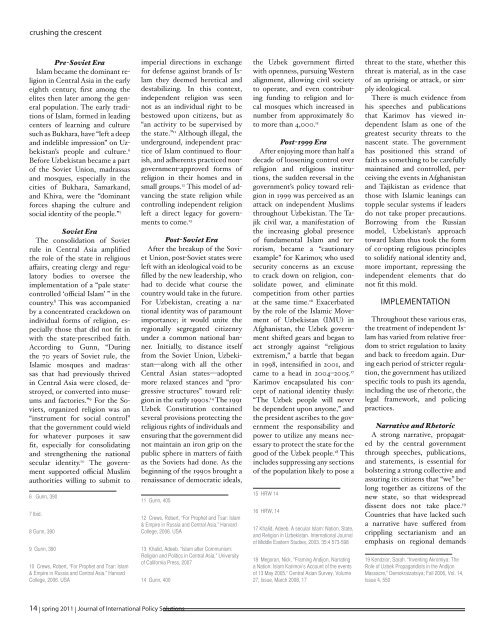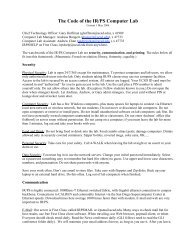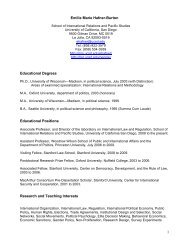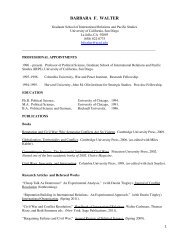to download the full journal. (1.2MB PDF) - School of International ...
to download the full journal. (1.2MB PDF) - School of International ...
to download the full journal. (1.2MB PDF) - School of International ...
You also want an ePaper? Increase the reach of your titles
YUMPU automatically turns print PDFs into web optimized ePapers that Google loves.
crushing <strong>the</strong> crescent<br />
Pre-Soviet Era<br />
Islam became <strong>the</strong> dominant religion<br />
in Central Asia in <strong>the</strong> early<br />
eighth century, first among <strong>the</strong><br />
elites <strong>the</strong>n later among <strong>the</strong> general<br />
population. The early traditions<br />
<strong>of</strong> Islam, formed in leading<br />
centers <strong>of</strong> learning and culture<br />
such as Bukhara, have “left a deep<br />
and indelible impression” on Uzbekistan’s<br />
people and culture. 6<br />
Before Uzbekistan became a part<br />
<strong>of</strong> <strong>the</strong> Soviet Union, madrassas<br />
and mosques, especially in <strong>the</strong><br />
cities <strong>of</strong> Bukhara, Samarkand,<br />
and Khiva, were <strong>the</strong> “dominant<br />
forces shaping <strong>the</strong> culture and<br />
social identity <strong>of</strong> <strong>the</strong> people.” 7<br />
Soviet Era<br />
The consolidation <strong>of</strong> Soviet<br />
rule in Central Asia amplified<br />
<strong>the</strong> role <strong>of</strong> <strong>the</strong> state in religious<br />
affairs, creating clergy and regula<strong>to</strong>ry<br />
bodies <strong>to</strong> oversee <strong>the</strong><br />
implementation <strong>of</strong> a “pale statecontrolled<br />
‘<strong>of</strong>ficial Islam’ ” in <strong>the</strong><br />
country. 8 This was accompanied<br />
by a concentrated crackdown on<br />
individual forms <strong>of</strong> religion, especially<br />
those that did not fit in<br />
with <strong>the</strong> state-prescribed faith.<br />
According <strong>to</strong> Gunn, “During<br />
<strong>the</strong> 70 years <strong>of</strong> Soviet rule, <strong>the</strong><br />
Islamic mosques and madrassas<br />
that had previously thrived<br />
in Central Asia were closed, destroyed,<br />
or converted in<strong>to</strong> museums<br />
and fac<strong>to</strong>ries.” 9 For <strong>the</strong> Soviets,<br />
organized religion was an<br />
“instrument for social control”<br />
that <strong>the</strong> government could wield<br />
for whatever purposes it saw<br />
fit, especially for consolidating<br />
and streng<strong>the</strong>ning <strong>the</strong> national<br />
secular identity. 10 The government<br />
supported <strong>of</strong>ficial Muslim<br />
authorities willing <strong>to</strong> submit <strong>to</strong><br />
6 Gunn, 390<br />
7 Ibid.<br />
8 Gunn, 390<br />
9 Gunn, 390<br />
10 Crews, Robert, “For Prophet and Tsar: Islam<br />
& Empire in Russia and Central Asia.” Harvard<br />
College, 2006. USA<br />
imperial directions in exchange<br />
for defense against brands <strong>of</strong> Islam<br />
<strong>the</strong>y deemed heretical and<br />
destabilizing. In this context,<br />
independent religion was seen<br />
not as an individual right <strong>to</strong> be<br />
bes<strong>to</strong>wed upon citizens, but as<br />
“an activity <strong>to</strong> be supervised by<br />
<strong>the</strong> state.” 11 Although illegal, <strong>the</strong><br />
underground, independent practice<br />
<strong>of</strong> Islam continued <strong>to</strong> flourish,<br />
and adherents practiced nongovernment-approved<br />
forms <strong>of</strong><br />
religion in <strong>the</strong>ir homes and in<br />
small groups. 12 This model <strong>of</strong> advancing<br />
<strong>the</strong> state religion while<br />
controlling independent religion<br />
left a direct legacy for governments<br />
<strong>to</strong> come. 13<br />
Post-Soviet Era<br />
After <strong>the</strong> breakup <strong>of</strong> <strong>the</strong> Soviet<br />
Union, post-Soviet states were<br />
left with an ideological void <strong>to</strong> be<br />
filled by <strong>the</strong> new leadership, who<br />
had <strong>to</strong> decide what course <strong>the</strong><br />
country would take in <strong>the</strong> future.<br />
For Uzbekistan, creating a national<br />
identity was <strong>of</strong> paramount<br />
importance; it would unite <strong>the</strong><br />
regionally segregated citizenry<br />
under a common national banner.<br />
Initially, <strong>to</strong> distance itself<br />
from <strong>the</strong> Soviet Union, Uzbekistan—along<br />
with all <strong>the</strong> o<strong>the</strong>r<br />
Central Asian states—adopted<br />
more relaxed stances and “progressive<br />
structures” <strong>to</strong>ward religion<br />
in <strong>the</strong> early 1990s. 14 The 1991<br />
Uzbek Constitution contained<br />
several provisions protecting <strong>the</strong><br />
religious rights <strong>of</strong> individuals and<br />
ensuring that <strong>the</strong> government did<br />
not maintain an iron grip on <strong>the</strong><br />
public sphere in matters <strong>of</strong> faith<br />
as <strong>the</strong> Soviets had done. As <strong>the</strong><br />
beginning <strong>of</strong> <strong>the</strong> 1990s brought a<br />
renaissance <strong>of</strong> democratic ideals,<br />
11 Gunn, 405<br />
12 Crews, Robert, “For Prophet and Tsar: Islam<br />
& Empire in Russia and Central Asia.” Harvard<br />
College, 2006. USA<br />
13 Khalid, Adeeb. “Islam after Communism:<br />
Religion and Politics in Central Asia.” University<br />
<strong>of</strong> California Press, 2007<br />
14 Gunn, 400<br />
<strong>the</strong> Uzbek government flirted<br />
with openness, pursuing Western<br />
alignment, allowing civil society<br />
<strong>to</strong> operate, and even contributing<br />
funding <strong>to</strong> religion and local<br />
mosques which increased in<br />
number from approximately 80<br />
<strong>to</strong> more than 4,000. 15<br />
Post-1999 Era<br />
After enjoying more than half a<br />
decade <strong>of</strong> loosening control over<br />
religion and religious institutions,<br />
<strong>the</strong> sudden reversal in <strong>the</strong><br />
government’s policy <strong>to</strong>ward religion<br />
in 1999 was perceived as an<br />
attack on independent Muslims<br />
throughout Uzbekistan. The Tajik<br />
civil war, a manifestation <strong>of</strong><br />
<strong>the</strong> increasing global presence<br />
<strong>of</strong> fundamental Islam and terrorism,<br />
became a “cautionary<br />
example” for Karimov, who used<br />
security concerns as an excuse<br />
<strong>to</strong> crack down on religion, consolidate<br />
power, and eliminate<br />
competition from o<strong>the</strong>r parties<br />
at <strong>the</strong> same time. 16 Exacerbated<br />
by <strong>the</strong> role <strong>of</strong> <strong>the</strong> Islamic Movement<br />
<strong>of</strong> Uzbekistan (IMU) in<br />
Afghanistan, <strong>the</strong> Uzbek government<br />
shifted gears and began <strong>to</strong><br />
act strongly against “religious<br />
extremism,” a battle that began<br />
in 1998, intensified in 2001, and<br />
came <strong>to</strong> a head in 2004–2005. 17<br />
Karimov encapsulated his concept<br />
<strong>of</strong> national identity thusly:<br />
“The Uzbek people will never<br />
be dependent upon anyone,” and<br />
<strong>the</strong> president ascribes <strong>to</strong> <strong>the</strong> government<br />
<strong>the</strong> responsibility and<br />
power <strong>to</strong> utilize any means necessary<br />
<strong>to</strong> protect <strong>the</strong> state for <strong>the</strong><br />
good <strong>of</strong> <strong>the</strong> Uzbek people. 18 This<br />
includes suppressing any sections<br />
<strong>of</strong> <strong>the</strong> population likely <strong>to</strong> pose a<br />
15 HRW 14<br />
16 HRW, 14<br />
17 Khalid, Adeeb. A secular Islam: Nation, State,<br />
and Religion in Uzbekistan. <strong>International</strong> Journal<br />
<strong>of</strong> Middle Eastern Studies, 2003. 35:4 573-598<br />
18 Megoran, Nick. “Framing Andijon, Narrating<br />
a Nation: Islam Karimov’s Account <strong>of</strong> <strong>the</strong> events<br />
<strong>of</strong> 13 May 2005.” Central Asian Survey, Volume<br />
27, Issue, March 2008, 17<br />
threat <strong>to</strong> <strong>the</strong> state, whe<strong>the</strong>r this<br />
threat is material, as in <strong>the</strong> case<br />
<strong>of</strong> an uprising or attack, or simply<br />
ideological.<br />
There is much evidence from<br />
his speeches and publications<br />
that Karimov has viewed independent<br />
Islam as one <strong>of</strong> <strong>the</strong><br />
greatest security threats <strong>to</strong> <strong>the</strong><br />
nascent state. The government<br />
has positioned this strand <strong>of</strong><br />
faith as something <strong>to</strong> be care<strong>full</strong>y<br />
maintained and controlled, perceiving<br />
<strong>the</strong> events in Afghanistan<br />
and Tajikistan as evidence that<br />
those with Islamic leanings can<br />
<strong>to</strong>pple secular systems if leaders<br />
do not take proper precautions.<br />
Borrowing from <strong>the</strong> Russian<br />
model, Uzbekistan’s approach<br />
<strong>to</strong>ward Islam thus <strong>to</strong>ok <strong>the</strong> form<br />
<strong>of</strong> co-opting religious principles<br />
<strong>to</strong> solidify national identity and,<br />
more important, repressing <strong>the</strong><br />
independent elements that do<br />
not fit this mold.<br />
IMPLEMENTATION<br />
Throughout <strong>the</strong>se various eras,<br />
<strong>the</strong> treatment <strong>of</strong> independent Islam<br />
has varied from relative freedom<br />
<strong>to</strong> strict regulation <strong>to</strong> laxity<br />
and back <strong>to</strong> freedom again. During<br />
each period <strong>of</strong> stricter regulation,<br />
<strong>the</strong> government has utilized<br />
specific <strong>to</strong>ols <strong>to</strong> push its agenda,<br />
including <strong>the</strong> use <strong>of</strong> rhe<strong>to</strong>ric, <strong>the</strong><br />
legal framework, and policing<br />
practices.<br />
Narrative and Rhe<strong>to</strong>ric<br />
A strong narrative, propagated<br />
by <strong>the</strong> central government<br />
through speeches, publications,<br />
and statements, is essential for<br />
bolstering a strong collective and<br />
assuring its citizens that “we” belong<br />
<strong>to</strong>ge<strong>the</strong>r as citizens <strong>of</strong> <strong>the</strong><br />
new state, so that widespread<br />
dissent does not take place. 19<br />
Countries that have lacked such<br />
a narrative have suffered from<br />
crippling sectarianism and an<br />
emphasis on regional demands<br />
19 Kendzior, Sarah. “Inventing Akromiya: The<br />
Role <strong>of</strong> Uzbek Propagandists in <strong>the</strong> Andijon<br />
Massacre,” Demokraizatsiya; Fall 2006, Vol. 14,<br />
Issue 4, 550<br />
14 | spring 2011 | Journal <strong>of</strong> <strong>International</strong> Policy Solutions






